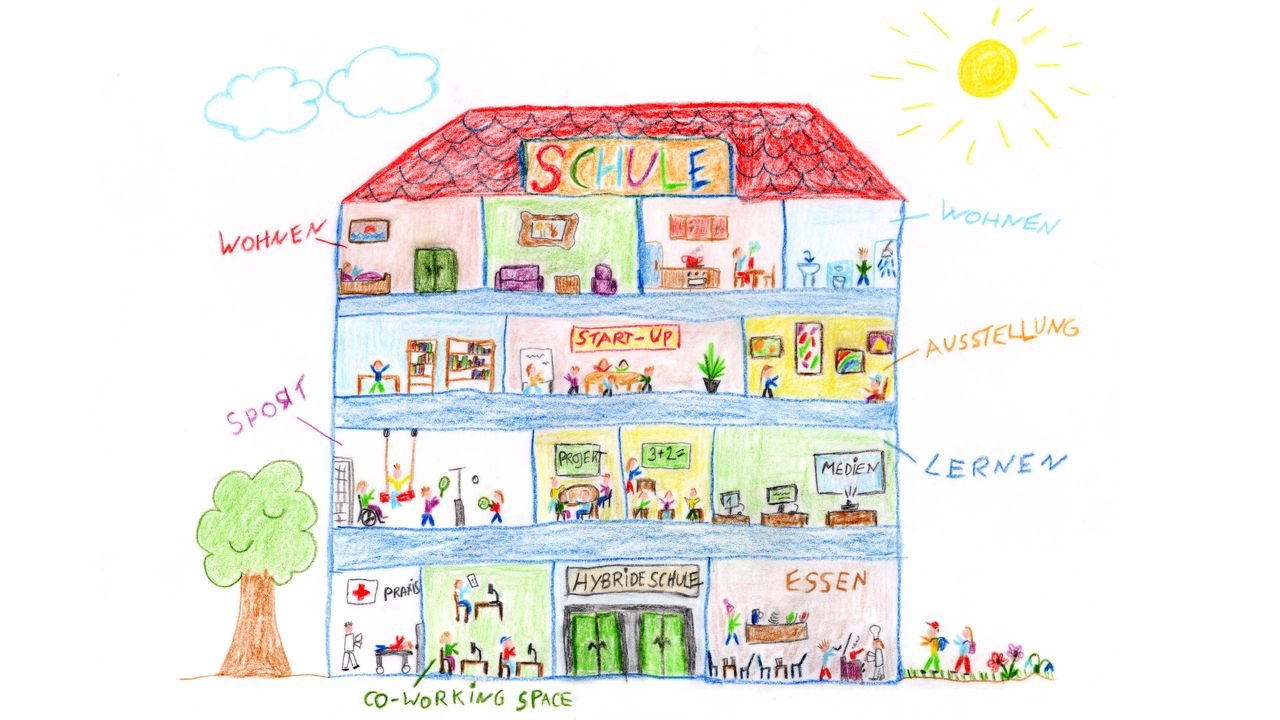
Demographic change, increasing migration, disruptive technologies, and innovative teaching and learning formats require classrooms living up to these developments. The interdisciplinary research project "The School as a Hybrid System" of the Institute for Building Design and Technology of Karlsruhe Institute of Technology (KIT) develops a holistic concept for school buildings to combine a variety of functions. The project is funded by the Federal Institute for Research on Building, Urban Affairs and Spatial Development under the Future Building Innovation Program.
"The pandemic has clearly shown the importance society attaches to schools," says Dr. Mandana Sedighi from the Supporting Structures Group of KIT's Institute for Building Design and Technology. "Apart from the currently necessary introduction of digital learning platforms, many schools are now reaching their limits with the rooms they offer and the structure and design of these rooms," says the Head of the Project "Schule als hybrides System - Systematische Untersuchung zur Entwicklung eines architektonisch-pädagogischen Konzepts für Schulen als hybrides System" (systematic investigation for the development of an architectonic-pedagogic concept for schools as hybrid systems). Project studies will open up new perspectives for the new construction and renovation of schools. Most school buildings in Germany date back to the 20th, sometimes even to the 19th century. "Their architecture reflects the society's conceptions of education of those times. Often, schools do not meet current requirements," Sedighi says. The research project focuses on the different architectures of schools and on various pedagogic approaches and studies to what an extent hybrid architectonic-pedagogic concepts can create free space for new education experiences and the society's participation through integration and inclusion.
School for Various User Groups
"The school as a hybrid system combining various functions can integrate various actors in addition to pupils and teachers and can create new education networks and experiences. The hybrid school is a contribution to actively shape a sustainable future," says the initiator of the project. For instance, coworking spaces for startups might be set up in school buildings. "This would enable children to watch use of digital media or programming languages in the work environment," she says. The school canteen might be opened to the staff of startups and to parents. Rooms might be used for exhibitions, leisure and health offers, and training as well as for cooperation with companies and service providers in the neighborhood. "This way, school could extend its educational task," the scientist points out. In cities with housing shortage, a story might be added to the school building in order to increase housing capacity.
Making Existing Schools Fit for the Future
Schools need flexible areas that can be used in various ways for teaching methods and learning formats suited for all-day schooling and inclusion. These areas should offer spaces for teamwork and individual work, including digital learning places, exercise areas, rest areas, and canteens. The research project is aimed at developing a tool kit of architectonic modules for a variety of renovation projects depending on local conditions and requirements. When renovating and hybridizing school buildings, Sedighi recommends to creatively use existing space elements. Classrooms in old school buildings mostly are small and designed for lecture-style teaching. Corridors are long and narrow. To make such a school building viable for the future, walls without any supporting function might be removed to obtain larger, variable spaces. Partitions between classrooms and corridors might be replaced by glass elements in order to let in daylight or provided with niches to create corners for individual work. "A corridor may be turned into a learning road. A library or mobile workplaces for parents might be integrated in the open entrance areas of schools," Sedighi says.
The project that started in 2019 and is scheduled until May 2021 is funded with about EUR 100,000 by the Federal Institute for Research on Building, Urban Affairs and Spatial Development under the Future Building Innovation Program. The research partner of KIT is the Faculty of Human Sciences of the University of Cologne.
Being "The Research University in the Helmholtz Association", KIT creates and imparts knowledge for the society and the environment. It is the objective to make significant contributions to the global challenges in the fields of energy, mobility, and information. For this, about 9,600 employees cooperate in a broad range of disciplines in natural sciences, engineering sciences, economics, and the humanities and social sciences. KIT prepares its 23,300 students for responsible tasks in society, industry, and science by offering research-based study programs. Innovation efforts at KIT build a bridge between important scientific findings and their application for the benefit of society, economic prosperity, and the preservation of our natural basis of life. KIT is one of the German universities of excellence.






